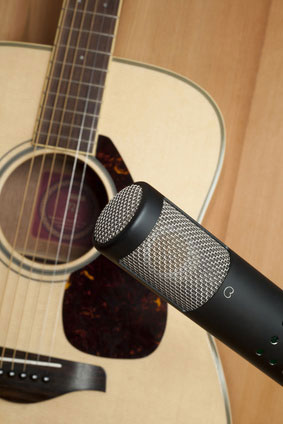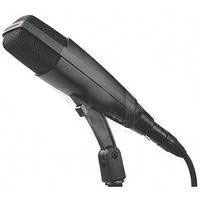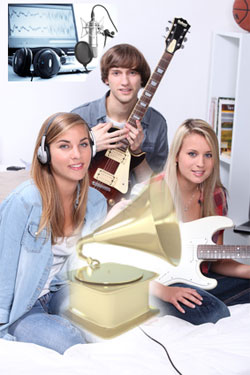 I record acoustic guitar a LOT. It’s my primary instrument and features in 99% of all my recordings. So I’ve learned some tricks along the way for getting a great acoustic guitar sound. But that doesn’t mean I can’t learn some new ones.
I record acoustic guitar a LOT. It’s my primary instrument and features in 99% of all my recordings. So I’ve learned some tricks along the way for getting a great acoustic guitar sound. But that doesn’t mean I can’t learn some new ones.
Björgvin Benediktsson just wrote an article with his top ten tips for recording acoustic guitar. Most of them I already do. Some I’ve never tried – putting a mic at the first fret is one of those. I’d like to add a couple of things to his list.
One of his tips is to “record in stereo,” by which he means recording with either a stereo microphone or with two microphones in a stereo configuration, such as the “coincident pair,” which means that two mics are placed with their capsules as close together as possible, but angled differently toward the guitar. And that is a fantastic way to get a stereo sound. But I would like to add the way I do it – which is basically “fake stereo” but doesn’t require you to have two mics or a stereo mic. You just record the guitar part once. Then on a second track, record the SAME part (meaning play it again!) again. Then pan the two parts left and right. The differences in the way you play the part will be enough to give you a great, full, wide guitar sound.
This was actually on Björgvin’s list under his tip for using different mics for double-tracking, which is the more formal term for doing my fake stereo thing. But his point was more for the added variety of sound when using two different mics rather than on using double-tracking as another way to achieve stereo.
One other tip I would add to his list is to pay very close attention to where the mic is pointing on your guitar, as well as the angle and distance. Make a note of it. Memorize it. This is because you will often need to stop a recording to do extra takes. And if anything is different, the angle, where the mic is pointing, etc. you will get a very different sound, which you do not want (unless you’re going for something whacky) on a single guitar track. It will sound jarring and just plain bad. So when doing additional takes, be sure to maintain the mic in relation to the guitar. Then double-check the consistency of the tone by listening through the transition from first take to second. I recently had to re-record an entire acoustic guitar track because I didn’t remember how I recorded the original days earlier, and I just could not duplicate the tone. Save yourself the time and effort by noting the details, and if possible, record the entire track on the same day in the same session. Of course, doing it all in one take is preferable.). Shya. Good luck with that.
Here is Björgvin’s article: http://audio-issues.com/recording-tips/top-ten-methods-for-recording-acoustic-guitar/#axzz2UJg6eXtR
Archives for May 2013
A Different But Awesome Drum Mic Position
Yesterday I wrote a bit about microphones for real drum kits. So in that same vein, I’m sharing another article about the position of a drum mic – over the drummer’s shoulder. Graham Cochrane tells about this technique in the below article. You can use it as the only mic if you want to only use one mic for recording drums. You can use it as one of a pair of overheads, or a mono overhead mic. Some of the advantages are that it picks up less cymbal wash, and also serves as a sort of close-miking thing for the entire kit, which helps to minimize room noise, which is a desirable thing when recording in a less-than-desirable room/space.
Check out Graham’s post here: http://therecordingrevolution.com/2013/05/24/the-over-the-shoulder-drum-mic-technique/
Cheers!
Ken
Drum Kit Mic For Toms

I don’t have a real drum kit – though I have always wanted one (He’s whining. Ignore him). there has always been a female in my life to stop me owning my own kit. First it was my mom. Now it is my wife. She says if we ever get a house with a basement, I can have a drum kit. Shya. Anyway…
I mostly record small drums (bodhran, dumbek, tupan, tamborine, etc.) the “real” way, meaning with an actual microphone. If I want to record a rock or pop song, I use sampled drums, typically in the form of Storm Drum (what I used on my cover of My Eyes, from Dr. Horrible, and That Thing You Do, from The Movie of the same name, which you can check out here and here, respectively), Jamstix (what I used on my cover of You’re All I Have, by Snow Patrol, which you can hear and read all about here), and Drum Experience, which I will probably use for every virtual drum kit I ever use in the future (it’s THAT awesome – check it out here.
However, if you are fortunate enough to have real drums that you can record, here is a tutorial one recording just one of them, the tom. You typically mic each drum nowadays, and there is a different mic for each. For example it’s common to use a Shure SM81 on the snare, something like a Shure Beta 52 on the kick, and as in the following video, a Sennheiser MD421.
So here is the video – another form WinkSound. Enjoy!
Some More EQ Tips For Music Mixing – 7 Important Frequencies
I just read another post that you might want to bookmark. It is about using equalization (EQ) when mixing music – a very common topic, but something that takes a lot of practice to get right. People usually do too much with EQ at first. Then with experience, when you realize exactly why you are using EQ and what it’s doing to your audio, you start to understand that a subtle use of this tool is how you get the best results. One really useful reference guide to have handy when using EQ is a description of what frequencies affect what types of instruments and elements of your song. For example, it is super handy to know that bass guitar is around 80-100 Hz, or that the human voice is primarily in the 2-3 KHz area. Knowing where the different instruments and sound “live” on the frequency spectrum is pretty important stuff.
This post has a list of seven EQ frequency bands that you might want to print out and tape to something near your computer:
http://productionadvice.co.uk/using-eq/
Can Award-Winning Recordings Be Made In A Home Recording Studio?
 I just read an article entitled “Can Award-Winning Recordings Be Made In A Home Studio?” But before I even read a word of the article, I had my hackles up (a thing my wife says when something gets her quickly in “defensive-mode”). That’s because the title alone made me say “what do you mean by “home studio,” and what awards are you talking about? We (my wife, Lisa Theriot and I) were finalists for an award called a “Voicey Award,” bestowed by Voices.com for voice-over recordings. So based on that, I’d say “of course” to the question posed in the title. We recorded our audio in a home studio, as did the eventual winner of our category.
I just read an article entitled “Can Award-Winning Recordings Be Made In A Home Studio?” But before I even read a word of the article, I had my hackles up (a thing my wife says when something gets her quickly in “defensive-mode”). That’s because the title alone made me say “what do you mean by “home studio,” and what awards are you talking about? We (my wife, Lisa Theriot and I) were finalists for an award called a “Voicey Award,” bestowed by Voices.com for voice-over recordings. So based on that, I’d say “of course” to the question posed in the title. We recorded our audio in a home studio, as did the eventual winner of our category.
The other thing that got me a bit rankled is that I generally despise the idea of awards for media productions. We make recordings for various reasons but few of us are out to “win an award.” Heck, most folks I talk to would be really happy if they could just get their audio to sound more professional. Who cares about an award? And my last word on awards and home studios is to point out how many major non-home studio recordings there are that have not won awards.
OK. Now that I’ve got that out of my system, let talk about the article.
First, the author, Bob Buontempo, specifies what he means by “award” (or at least level of award) when he says “i.e. – Grammy.” He’s talking specifically about music and not spoken-word/voice-over work. And he’s talking really prestigious, world-stage awards. That narrows things down a bit.
Next, he suggests that his definition of a home studio is “everything is in the spare bedroom,” because he states that it would be improbable to win a Grammy because you can’t fit a whole band (and that’s debatable) or an entire orchestra into a bedroom. Well, when you so narrowly define “home studio,” you make it much less likely for a recording made that way to be capable of winning a Grammy.
However, as the article goes on, there are suggestions that under the right circumstances, it is absolutely possible for a home studio recording to achieve Grammy caliber. It mostly comes down to the performance and the song. After that, it comes down to the knowledge of the engineer.
Yes, it is a fact that a large commercial recording studio is going to have more gear options, and that gear is likely to cost a LOT more than the typical home studio is likely to ever be able to afford. Also it is a fact that most recording and listening spaces in large commercial studios will have superior acoustics, which makes for more accurate mixing and better mastering.
Oh, yeah – the mastering thing. The author did not specify whether a home recording that is sent to a professional mastering facility counts as “a recording made in a home studio.” It should. Even the big studios send mixes to separate mastering facilities.
And this, for me, is the elephant in the room. Take 100 people off the street. Heck, even make them music loving people. Then ask them to listen and tell you the difference between a 24-bit/192KHz recording and a 16-bit/44.1KHz recording, and I would wager they could not tell you. I’d even be willing to bet most of them could not say which was an mp3 if you threw that into the mix! The purist may argue that the difference would be noticeable when played on a super high-end audio system. Maybe. But then what percentage of the music-consuming public are listening to high-definition music on high-end systems. A very tiny fraction.
So though on paper, the audio created in a home recording studio cannot, by the specs, go head-to-head with the major studio recordings, at the end of the day I say “so what?” People listening to music don’t look at specs. They listen to music. And the specs mean nothing if the recordings sound good. And recordings made in home studios are perfectly capable of sounding good.
Now for my final take on this question – do most recordings that people make in their home studios sound as good as the pros? In my experience they absolutely do not. That is because the gear is so affordable and anyone can get it now. That means there are thousands of people making home recordings with gear they don’t know how to use. I’ve said this many times – people with no audio knowledge, but with a million dollars worth of equipment can (and usually do) make crappy recordings if they know what they are doing. However, someone who DOES know what they are doing can make awesomely professional sounding recordings with a few hundred dollars worth of gear. It’s about the knowledge. One other thing I also say is that you can get that knowledge on Home Brew Audio. We make the daunting techno-jargon easy to understand so you can make great – even award-winning audio – in your home studio.
Cheers!
Ken
BTW, the original article is here: http://www.prosoundweb.com/article/can_grammy_winning_recordings_be_made_in_a_home_studio/